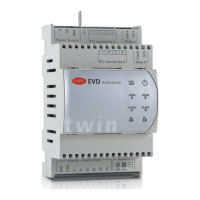ENG
“EVD Evolution TWIN” +0300006EN - rel. 2.6 - 31.01.2019
53
Parameter/description Def.
Relay conguration:
1= Disabled
2= Alarm relay (open when alarm active)
3= Solenoid valve relay (open in standby)
4= Valve + alarm relay (open in standby and control alarms)
5= Reversed alarm relay (closed in case of alarm)
6= Valve status relay (open if valve is closed)
7= Direct control
8= Failed closing alarm relay(open with alarm)
9= Reverse failed closing alarm relay (closed with alarm)
Alarm
relay
Tab. 9.b
9.3 Probe alarms
The probe alarms are part of the system alarms. When the value measured
by one of the probes is outside of the eld dened by the parameters
corresponding to the alarm limits, an alarm is activated. The limits can be set
independently of the range of measurement. Consequently, the eld outside
of which the alarm is signalled can be restricted, to ensure greater safety of
the controlled unit.
Important: in applications that use programmable control it may be
necessary to exclude the alarms generated by the probes:
Parameter/description Def. Min. Max. UOM
PROBES
Enable S1 1 0 1 -
Enable S2 1 0 1 -
Enable S3 1 0 1 -
Enable S4 1 0 1 -
Note:
• the alarm limits can also be set outside of the range of measurement, to
avoid unwanted probe alarms. In this case, the correct operation of the unit
or the correct signalling of alarms will not be guaranteed;
• by default, after having selected the type of probe used, the alarm limits
will be automatically set to the limits corresponding to the range of
measurement of the probe.
Parameter/description Def. Min. Max. UOM
PROBESs
S1 alarm MIN pressure (S1_
AL_MIN)
-1 -20 (-290) S1_AL_MAX barg (psig)
S1 alarm MAX pressure (S1_
AL_MAX)
9.3 S1_AL_MIN 200 (2900) barg (psig)
Alarm delay S1 0 0 240 s
S2 alarm MIN temp.
(S2_AL_MIN)
-50 -60 S2_AL_MAX °C/°F
S2 alarm MAX temp. (S2_
AL_MAX)
105 S2_AL_MIN 200 (392) °C (°F)
Alarm delay S2 0 0 240 s
S3 alarm MIN pressure (S3_
AL_MIN)
-1 -20 S3_AL_MAX barg (psig)
S3 alarm MAX pressure (S3_
AL_MAX)
9.3 S3_AL_MIN 200 (2900) barg (psig)
Alarm delay S3 0 0 240 s
S4 alarm MIN temp.
(S4_AL_MIN)
-50 -60 S4_AL_MAX °C/°F
S4 alarm MAX temp. (S4_
AL_MAX)
105 S4_AL_MIN 200 (392) °C (°F)
Alarm delay S4 0 0 240 s
Tab. 9.c
The behaviour of the driver in response to probe alarms can be congured,
using the manufacturer parameters. The options are:
• no action (control continues but the correct measurement of the variables
is not guaranteed);
• forced closing of the valve (control stopped);
• valve forced to the initial position (control stopped).
Parameter/description Def. Min. Max. UOM
CONFIGURATION
Probe S1 alarm management:
1= No action
2= Forced valve closing
3= Valve in xed position
4= Use backup probe S3 (*)
(*)= CANNOT BE SELECTED
Valve in xed position - - -
Probe S2 alarm management:
1= No action
2= Forced valve closing
3= Valve in xed position
4= Use backup probe S4 (*)
(*)= CANNOT BE SELECTED
Valve in xed position - - -
Probe S3 alarm management:
1= No action
2= Forced valve closing
3= Valve in xed position
No action - - -
Probe S4 alarm management:
1= No action
2= Forced valve closing
3= Valve in xed position
No action - - -
CONTROL
Valve opening at start-up (eva-
porator/valve capacity ratio)
50 0 100 %
Tab. 9.d
9.4 Control alarms
These are alarms that are only activate during control.
Protector alarms
The alarms corresponding to the LowSH, LOP and MOP protectors are only
activated during control when the corresponding activation threshold is
exceeded, and only when the delay time dened by the corresponding
parameter has elapsed. If a protector is not enabled (integral time= 0 s), no
alarm will be signalled. If before the expiry of the delay, the protector control
variable returns back inside the corresponding threshold, no alarm will be
signalled.
Note: this is a likely event, as during the delay, the protection function
will have an eect.
If the delay relating to the control alarms is set to 0 s, the alarm is disabled. The
protectors are still active, however. The alarms are reset automatically.
Low suction temperature alarm
The low suction temperature alarm is not linked to any protection function.
It features a threshold and a delay, and is useful in the event of probe or
valve malfunctions to protect the compressor using the relay to control the
solenoid valve or to simply signal a possible risk.
In fact, the incorrect measurement of the evaporation pressure or incorrect
conguration of the type of refrigerant may mean the superheat calculated
is much higher than the actual value, causing an incorrect and excessive
opening of the valve.
A low suction temperature measurement may in this case indicate the
probable ooding of the compressor, with corresponding alarm signal.
If the alarm delay is set to 0 s, the alarm is disabled. The alarm is reset
automatically, with a xed dierential of 3°C above the activation threshold.
Relay activation for control alarms
As mentioned in the paragraph on the conguration of the relay, in the event
of LowSH, MOP and low suction temperature alarms, the driver relay will open
both when congured as an alarm relay and congured as a solenoid + alarm
relay.

